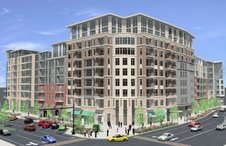Is the sprawl that has continually pushed Americans further away from the urban cores since World War II coming to an end?
That's the question posed by Eduardo M. Penalver, associate professor at Cornell Law School, in a recent Washington Post column, "The End of Sprawl?"
Penalver, who teaches property and land-use law, points out that, "American sprawl was built on the twin pillars of low gas prices and relentless demand for housing . . ."
However, according to Penalver, as gas prices continue rising, long commutes are becoming less desirable, and, "the price people are willing to pay for homes in remote areas will fall."
Meanwhile, according to the New Urbanist News (as cited in the article), "homes close to urban centers or that have convenient access to transit seem to be holding their value better than houses in car-dependent communities at the urban edge."
Penalver ends with a compelling statement on returning to walkable, urban neighborhoods:
"We may discover that it's not so bad living closer to work, in transit- and pedestrian-friendly, diverse neighborhoods where we run into friends and neighbors as we walk to the store, school or the office. We may even find that we don't miss our cars and commutes, and the culture they created, nearly as much as we feared we would."
Source: "The End of Sprawl?" by Eduardo M. Penalver
skip to main |
skip to sidebar

Building One at 1211 St. Clair
The Avenue District

Building One at 1211 St. Clair
National Gas Prices
CoolCleveland.com Videos
Subscribe via email
Avenue District Sales
Townhomes, elegant lofts and penthouses are available now in Cleveland's premier walkable neighborhood.
1238 St. Clair Ave.
12 p.m. to 5 p.m Monday-Friday
12 p.m. to 4 p.m. Saturday
Or by appointment
Frank Lalli
(216) 589.8524
frank.lalli@zarembahomes.com
1238 St. Clair Ave.
12 p.m. to 5 p.m Monday-Friday
12 p.m. to 4 p.m. Saturday
Or by appointment
Frank Lalli
(216) 589.8524
frank.lalli@zarembahomes.com
Links
RSS Feed
Welcome to The Avenue District.
The Avenue District will be a walkable neighborhood weaving seamlessly with The Theatre, Gateway, Civic, and Lakefront Districts and right next door to Cleveland State, and the Galleria. It will satisfy the need of urban dwellers looking for a downtown neighborhood that offers culture, entertainment, convenience, and accessibility. Construction is slated to begin in three phases, starting at East 12th Street and St. Clair Avenue, across from the Galleria and Erieview Tower.
The Avenue District
Visit our Sales Office
The Avenue District Sales Office is located at 1238 St. Clair Ave., giving visitors an up-close and personal view of progress on the 10-story condo building at 1211 St. Clair Ave.
We are open from 8:30 a.m. to 5 p.m Monday through Friday and 12 p.m. to 5 p.m. both Saturday and Sunday.
Contact Frank Lalli at 216.589.8524 or
frank.lalli@zarembahomes.com
We are open from 8:30 a.m. to 5 p.m Monday through Friday and 12 p.m. to 5 p.m. both Saturday and Sunday.
Contact Frank Lalli at 216.589.8524 or
frank.lalli@zarembahomes.com


